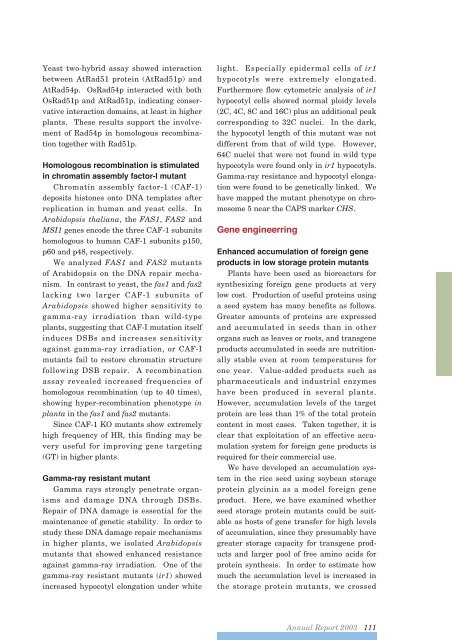You also want an ePaper? Increase the reach of your titles
YUMPU automatically turns print PDFs into web optimized ePapers that Google loves.
Yeast two-hybrid assay showed interactionbetween AtRad51 protein (AtRad51p) andAtRad54p. OsRad54p interacted with bothOsRad51p and AtRad51p, indicating conservativeinteraction domains, at least in higherplants. These results support the involvementof Rad54p in homologous recombinationtogether with Rad51p.Homologous recombination is stimulatedin chromatin assembly factor-I mutantChromatin assembly factor-1 (CAF-1)deposits histones onto DNA templates afterreplication in human and yeast cells. InArabidopsis thaliana, the FAS1, FAS2 andMSI1 genes encode the three CAF-1 subunitshomologous to human CAF-1 subunits p150,p60 and p48, respectively.We analyzed FAS1 and FAS2 mutantsof Arabidopsis on the DNA repair mechanism.In contrast to yeast, the fas1 and fas2lacking two larger CAF-1 subunits ofArabidopsis showed higher sensitivity togamma-ray irradiation than wild-typeplants, suggesting that CAF-I mutation itselfinduces DSBs and increases sensitivityagainst gamma-ray irradiation, or CAF-Imutants fail to restore chromatin structurefollowing DSB repair. A recombinationassay revealed increased frequencies ofhomologous recombination (up to 40 times),showing hyper-recombination phenotype inplanta in the fas1 and fas2 mutants.Since CAF-1 KO mutants show extremelyhigh frequency of HR, this finding may bevery useful for improving gene targeting(GT) in higher plants.Gamma-ray resistant mutantGamma rays strongly penetrate organismsand damage DNA through DSBs.Repair of DNA damage is essential for themaintenance of genetic stability. In order tostudy these DNA damage repair mechanismsin higher plants, we isolated Arabidopsismutants that showed enhanced resistanceagainst gamma-ray irradiation. One of thegamma-ray resistant mutants (ir1) showedincreased hypocotyl elongation under whitelight. Especially epidermal cells of ir1hypocotyls were extremely elongated.Furthermore flow cytometric analysis of ir1hypocotyl cells showed normal ploidy levels(2C, 4C, 8C and 16C) plus an additional peakcorresponding to 32C nuclei. In the dark,the hypocotyl length of this mutant was notdifferent from that of wild type. However,64C nuclei that were not found in wild typehypocotyls were found only in ir1 hypocotyls.Gamma-ray resistance and hypocotyl elongationwere found to be genetically linked. Wehave mapped the mutant phenotype on chromosome5 near the CAPS marker CHS.Gene engineerringEnhanced accumulation of foreign geneproducts in low storage protein mutantsPlants have been used as bioreactors forsynthesizing foreign gene products at verylow cost. Production of useful proteins usinga seed system has many benefits as follows.Greater amounts of proteins are expressedand accumulated in seeds than in otherorgans such as leaves or roots, and transgeneproducts accumulated in seeds are nutritionallystable even at room temperatures forone year. Value-added products such aspharmaceuticals and industrial enzymeshave been produced in several plants.However, accumulation levels of the targetprotein are less than 1% of the total proteincontent in most cases. Taken together, it isclear that exploitation of an effective accumulationsystem for foreign gene products isrequired for their commercial use.We have developed an accumulation systemin the rice seed using soybean storageprotein glycinin as a model foreign geneproduct. Here, we have examined whetherseed storage protein mutants could be suitableas hosts of gene transfer for high levelsof accumulation, since they presumably havegreater storage capacity for transgene productsand larger pool of free amino acids forprotein synthesis. In order to estimate howmuch the accumulation level is increased inthe storage protein mutants, we crossed<strong>Annual</strong> <strong>Report</strong> <strong>2003</strong> 111













